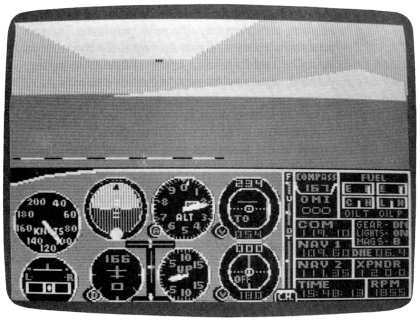40 More Great Flight Simulator Adventures
by Charles Gulick

Cutting
Patterns
Spanaway IV
Patterns
Spanaway IV
No parameters to set. You set up this mode at the end of the previous adventure. Your flight continues from where you left off.
 |
You've begun your letdown from
4000 feet for a landing at Spanaway. By
now you have Tacoma and the airport in sight, so you'll fly the
approach visually. Unless you're really skilled at entering a pattern,
pause while you consider the following: You're inbound for runway 16, which is, of course, on a heading of 160 degrees. Looking ahead at the runway-which end will you be landing on? Well, there's no substitute for being able to figure out by the numbers the traffic pattern around an airport. So it's nice to have a compass rose of some kind, either in the aircraft or in your head. Unless advised otherwise, or unless other aircraft you see are flying a right-hand pattern, assume every airport flies a left-hand pattern-in other words, all turns to all legs are left-hand turns. And all turns, once you're part of the pattern, are 90-degree turns. Finally, you should enter the pattern on the downwind leg at an angle of 45 degrees. The downwind leg is the reciprocal of the runway heading, the runway heading plus or minus 180 degrees. For Spanaway, downwind is 160 plus 180, or 340 degrees. Or it's 160 minus 180-minus 20 degrees-which is 360 (or 000) minus 20 which is 340. Is that clear? Next, you have to figure the entry heading, which for a left-hand pattern is the downwind heading minus 45 degrees. For a right-hand pattern it's downwind plus 45 degrees. For Spanaway, then, entry is 340 minus 45, or 295 degrees. Look at your heading indicator. And look at the runway. If you've thought out your landing direction correctly, you know that the downwind leg is this side of the runway. Ideally, you should enter downwind at an early enough point to make your turn and still have time to plan and execute the rest of your landing procedure. You'll want to make some directional changes to get into position. This you do while you're letting down. The objective is to enter the downwind leg at pattern altitude (we decided on 1400 feet) and pattern airspeed. We'll get to the question of pattern airspeed a little later in this adventure. Right now, you want to get to pattern altitude and into position to enter the downwind leg on a heading of 295 degrees. So unpause now, and go ahead and do that. Remember, you should change power settings to increase or decrease your rate of descent. As we've learned already, it'll decrease to some extent as your altitude decreases, depending on atmospheric pressure. To increase it, you'll need to decrease your rpm, thus pitching your nose down more steeply. Though you may turn considerably away from the airport at Spanaway in order to get into your desired entry position, regularly check on where the runway is by using the side views. As you get closer, Spanaway will come into sight on radar, too-an additional help. |
|
 |
If you mess up trying to make
this descent and pattern entry, use the
reset (called Recall for the IBM) key, and try again. You're not that
far out, and reflying it will give you some valuable practice. In fact, you may want to press the reset now (PrtSc on the IBM, Del on the PCjr, = on the Atari, + on the Commodore 64, and SHIFT-+ on the Apple). Since you've read about getting into the entry position once already, you can start the task earlier, perhaps doing a better job of it. Watch your altimeter, and adjust your power to vary your descent according to your best judgment as to where and when you're going to enter the pattern. |
|
 |
This transition takes time, so begin early so that you're straight and level at pattern altitude by the time you enter the downwind leg. Make all elevator adjustments gradually. Otherwise, you'll get on a roller coaster. Don't chase the vertical speed indicator. Its middle name is lag. |
|
 |
Once you're downwind, get the
runway in sight with a direct side view.
If you can't see it (except on radar), you're in too close. You may
still be able to execute your landing okay, but plan further ahead next
time. As for landing-well, that's for the next adventure. It will help you perfect yours, right here at Spanaway. Even your eyebrows will sprout wings. |
Table of Contents | Previous Section | Next Section
